Debris Flow 2012
4th International Conference on Monitoring, Simulation, Prevention and Remediation of Dense and Debris Flow
29 - 31 May 2012
Dubrovnik, Croatia
Overview and Opening Address
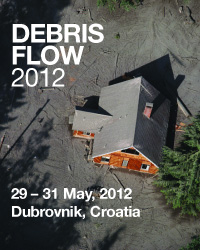
The 4th International Conference on Monitoring, Simulation, Prevention and Remediation of Dense and Debris Flow (Debris Flow 2012) took place at the Inter University Centre in Dubrovnik, jointly organised by the Wessex Institute of Technology, represented by Professor Carlos A Brebbia, the State University of Milano, represented by Professor Daniele De Wrachien, and the Politecnico di Milano, represented by Professor Stefano Mambretti. The meeting was co-sponsored by the European Society of Agricultural Engineers and the International Commission of Agricultural Engineering.
This successful series of conferences first started in Rhodes (2006), and continued in the New Forest (2008) and in Milano (2010).
Debris and hyper-concentrated flows are amongst the most destructive of all water related disasters. These hazards are likely to become more frequent and more severe in the future due to the effects of increase in population, urbanisation, land subsidence and the impact of climate change. They affect both residential urban communities, particularly in river basins and mountainous areas, and in recent years have attracted more and more attention from the scientific and professional communities as well as concern from the public due to the death toll they claim.

The event brought together engineers, scientists and managers from across the globe to discuss some of the latest scientific advances in the field of dense and hyper-concentrated flows, as well as to improve models, assess risks and to design prevention and mitigation measures.
The conference was opened by Professor Carlos A Brebbia who stressed the importance of the series to further the objectives of the Wessex Institute of Technology (WIT), which aims to disseminate knowledge at an international level. Debris Flow is one of the 25 or so conferences that the Institute organises every year. They are all specialised meetings mostly of an interdisciplinary nature and attended by senior specialists as well as younger researchers.
WIT’s other activities in its New Forest Campus include research at both PhD and Master level, as well as advanced consulting for industry.
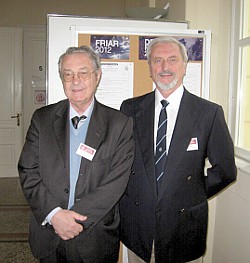
The output of WIT Press is nowadays published in digital format, as well as in hard copy. The conference proceedings are indexed and all papers are permanently displayed in the Web Library of WIT Press (http://library.witpress.com/). The distribution network of WIT Press ensures that the work presented at WIT conferences is rapidly known throughout the world.
Following Carlos’ remarks, Prof De Wrachien welcomed the participants on behalf of the State University of Milano, which has a link agreement with the Wessex Institute of Technology to cover a series of joint activities. He also represents the international associations sponsoring the conference.
Conference Topics
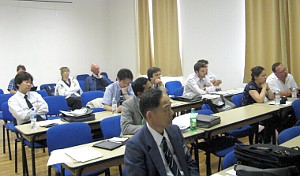
The papers presented at the conference were grouped within the following topics:
- Debris Flow Modelling
- Monitoring and Measurement
- Risk Assessment
- Sediment Transport and Debris Flow
- Protective Barriers
- Landslide Phenomena
They represent a valuable contribution to ‘lessons learned’ and to the design of a new balanced approach aiming at reducing the vulnerability of the environment to debris flow related hazards.
Invited Presentations
There were a series of invited presentations to enhance the proceedings:
‘Two Methods for Measuring Internal Velocity of Debris Flow in the Laboratory’
F Wei, Chinese Academy of Sciences
‘Modelling of Soil Erosion and Sediment Transport under Different Land Management Options in Southern-Italy Watershed’
F Gentile, University of Bari, Italy
‘Bedload Transport as an Indicator of Present Transformation of Arctic Fluvial Systems’
W Kociuba, Maria Curie Sklodowska University, Poland
‘Empirical Methods for the Estimation of Debris Flow Deposition Areas’
D De Wrachien, State University of Milano, Italy
‘Ontology for Flood Management: a Proposal’
S Mambretti, Politecnico di Milano, Italy
The conference also included an interesting video on the Rio Cordon event presented by Francesco Bettella of Padova University, by kind permission of its originator, Professor D’Agostino of the same University. This is a previous event that illustrates how a debris catchment area has functioned during a major debris flow occurrence, preventing a major incident taking place in spite of exceptional conditions, including boulders over a metre diameter. The total amount of transported sediment was 2,000m3 and the flood in question has a return period of 40 years.
Social Occasions
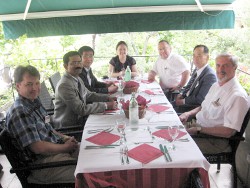
The International Scientific Advisory Committee met over dinner to discuss how the conference could evolve, when it is reconvened in 2014. Different topics were proposed including more emphasis on preventative measures and early warning systems. Locations for 2014 were also discussed and WIT will investigate them in detail in the next few months. Carlos expressed the gratitude of the Conference Chairmen to the members for their support of the meeting and the work carried out in reviewing abstracts and papers.
The delegates were offered a guided tour of the old city of Dubrovnik at the end of one afternoon. The City of Dubrovnik, or Ragusa to give it its ancient name, started as a refuge against the Slavic invaders who destroyed the Roman settlements along the coast. This took place in the 7th century and two hundred years later the inhabitants were able to resist a Saracen siege that lasted longer than one year. Over the next few centuries it was to become an important trading centre linking each and west, and becoming part of the Venice for nearly 150 years.
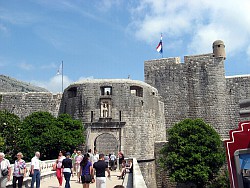
The discovery of America and new trading routes to the Indies, saw the decline of Ragusa, culminating in the Napoleonic force’s invasion of 1808. Following the fall of France they were to fall under Austro-Hungarian rule. This lasted until 1918, ie the end of the first world war, when they were to become part of the newly created republic of Yugoslavia.
It was only recently that Dubrovnik became part of Croatia, following the disintegration of Yugoslavia. Although the city was bombed during the related hostilities it has now been totally renovated and rebuilt.
The most impressive sight in Dubrovnik are the city walls which were a deterrent to invaders and ensured the security of the inhabitants over centuries. The city also has a powerful fleet that consisted at its highest point of 300 ships.
Most of the city was destroyed during the 1667 earthquake, with the exception of the Rector’s Palace, and a few other buildings. Reconstruction of the city led to one of the earliest and most successful examples of town planning, producing a very pleasing type of architecture.
Dubrovnik is renowned for its beautiful Churches and numerous cultural activities including a lively music scene ranging from classical to modern, resulting in a continuous series of concerts throughout the summer.
Dubrovnik is without doubt a jewel of a city and a demonstration of the resilience of the human spirit, having survived numerous major disasters through its long history.
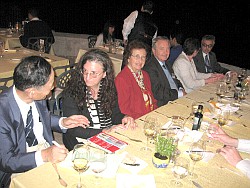
Carlos closed the conference by thanking all delegates for having participated and letting them know that the next meeting will take place in 2014 in a place and at date to be shortly decided.
Conference Proceedings
The proceedings of Debris Flow, 264pp (Print ISBN: 978-1-84564-586-1; eISBN: 978-1-84564-587-8) are available from WIT Press. Orders can be placed on the WIT Press web site at www.witpress.com or by email:
Papers from the conference will also be hosted online at the WIT eLibrary as Volume 73 of WIT Transactions on Engineering Sciences (ISSN: 1746-4471, Digital ISSN: 1743-3533). For more details visit the WIT eLibrary at http://library.witpress.com

 Wessex Institute
Wessex Institute